
The Australian Grand Prix is an annual motor racing event which is under contract to host Formula One until 2035. One of the oldest surviving motorsport competitions held in Australia, the Grand Prix has moved frequently with 23 different venues having been used since it was first run at Phillip Island in 1928. The race became part of the Formula One World Championship in 1985. Since 1996, it has been held at the Albert Park Circuit in Melbourne, with the exceptions of 2020 and 2021, when the races were cancelled due to the COVID-19 pandemic. Before that, it was held in Adelaide.
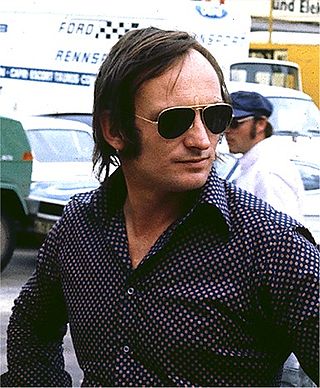
Christopher Arthur Amon was a New Zealand motor racing driver. He was active in Formula One racing in the 1960s and 1970s, and is widely regarded as one of the best F1 drivers never to win a championship Grand Prix. His reputation for bad luck was such that fellow driver Mario Andretti once joked that "if he became an undertaker, people would stop dying". Former Ferrari Technical Director Mauro Forghieri stated that Amon was "by far the best test driver I have ever worked with. He had all the qualities to be a World Champion but bad luck just wouldn't let him be".
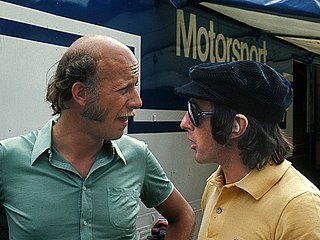
The 1973 Formula One season was the 27th season of FIA Formula One motor racing. It featured the 1973 World Championship of Drivers and the 1973 International Cup for F1 Manufacturers, which were contested concurrently over a fifteen-race series that commenced on 28 January and ended on 7 October. There were two new races for the 1973 season – the Brazilian Grand Prix at Interlagos in São Paulo and the Swedish Grand Prix at Anderstorp. The season also included two non-championship races which were open to both Formula One and Formula 5000 cars.
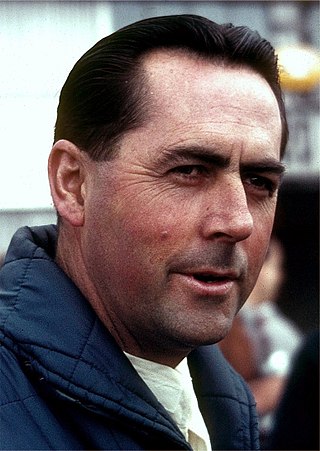
The 1966 Formula One season was the 20th season of FIA Formula One motor racing. It featured the 1966 World Championship of Drivers and the 1966 International Cup for F1 Manufacturers which were contested concurrently over a nine-race series that commenced on 22 May and ended on 23 October. The season saw the "return to power" with the introduction of the '3 litre formula', doubling maximum engine capacity from 1.5 litres. Jack Brabham won the World Championship of Drivers and Brabham-Repco was awarded the International Cup for F1 Manufacturers.
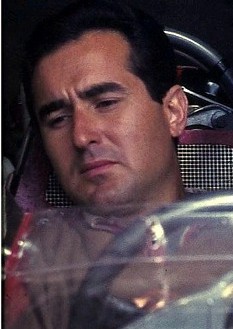
Lorenzo Bandini was an Italian motor racing driver who raced in Formula One for the Scuderia Centro Sud and Ferrari teams.

Formula 5000 was an open wheel, single seater auto-racing formula that ran in different series in various regions around the world from 1968 to 1982. It was originally intended as a low-cost series aimed at open-wheel racing cars that no longer fit into any particular formula. The '5000' denomination comes from the maximum 5.0 litre engine capacity allowed in the cars, although many cars ran with smaller engines. Manufacturers included McLaren, Eagle, March, Lola, Lotus, Elfin, Matich and Chevron.

Oran Park Raceway was a motor racing circuit at Narellan south west of Sydney, New South Wales, Australia which was operational from February 1962 until its closure in January 2010. The track was designed and started by George Murray and Jack Allen. Since its closure in 2010 it has been developed into housing.

Pukekohe Park is a horse racing, motor racing, and community events facility located in Pukekohe, New Zealand, approximately 40 km (25 mi) south of the Auckland CBD, in the Auckland Region of the North Island. The venue, owned by Counties Racing Club Inc. is used seven days a week for horse training, driver training, motor sport events, cycling and various events and functions.

Neil Crompton is a well-known Supercars presenter and commentator.

The BRM P261, also known as the BRM P61 Mark II, is a Formula One motor racing car, designed and built by the British Racing Motors team in Bourne, Lincolnshire, England. The BRM P261 was introduced for the 1964 Formula One season, and its design was an evolution of Tony Rudd's one-off BRM P61 car of 1963. The P261 had a relatively long racing career; variants of the car were still being entered for Formula One World Championship Grands Prix as late as 1968. During the course of their front-line career BRM P261s won six World Championship races, in the hands of works drivers Graham Hill and Jackie Stewart, and finished second in both the Drivers' and Constructors' Championship standings in 1964 and 1965. Stewart, Hill and Richard Attwood also used works P261s to compete in the Tasman Series in 1966. The BRMs dominated, with Stewart winning four, Hill two, and Attwood one of the 1966 Tasman Series' eight races. Stewart also won the title. The works-backed Reg Parnell Racing team returned in 1967 with Stewart and Attwood, where Stewart added another two wins to his tally. In terms of races won and total Championship points scored, the P261 was the most successful car in BRM's history.
The 1966 Tasman Championship for Drivers was a motor racing competition for racing cars complying with the Tasman Formula. The championship was jointly organised by the Association of New Zealand Car Clubs Inc. and the Confederation of Australian Motor Sport. It began on 8 January 1966 and ended on 7 March after eight races, four of which were staged in New Zealand and the remainder in Australia. The winning driver was declared Tasman Champion and was awarded the Tasman Cup.
Frank GardnerOAM was a racing driver from Australia. Born in Sydney, he was best known for touring car racing, winning the British Saloon Car Championship three times, and sports car racing driver but he was also a top flight open wheeler driver. He was European Formula 5000 champion, and participated in nine World Championship Formula One Grands Prix, debuting on 11 July 1964. He scored no championship points. Gardner also participated in numerous non-Championship Formula One races and his results included a third placing at the 1965 Mediterranean Grand Prix at the Autodromo di Pergusa in Sicily, fourth in the 1965 Race of Champions at Brands Hatch and third in the 1971 International Gold Cup at Oulton Park. He participated each year in the open wheeler Tasman Series held in New Zealand and Australia during the European winter, and shared the grids with the likes of Jim Clark, Graham Hill and Jochen Rindt and won the New Zealand Grand Prix.
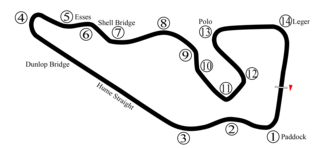
The 1967 Australian Grand Prix was a motor race held over 45 laps of the 3.621 km (2.25 mi) Warwick Farm Raceway in Sydney, New South Wales, Australia on 19 February 1967. The race, which was open to Australian National Formula and Australian 1½ Litre Formula cars, had 15 starters.

The 1966 Australian Grand Prix was a motor race staged on 20 February 1966 at the Lakeside Circuit in Queensland, Australia. The race, which had 15 starters, was open to Racing Cars complying with the Australian National Formula or the Australian 1½ Litre Formula. It was both the 31st Australian Grand Prix and race 6 of the 1966 Tasman Championship for Drivers.

The 1968 Australian Grand Prix was a motor race held at Sandown Park in Victoria, Australia on 25 February 1968. The race was open to Racing Cars complying with the Australian National Formula or the Australian 1½ Litre Formula. It was the thirty third Australian Grand Prix and was also round seven of the 1968 Tasman Series. The race was staged by the Light Car Club of Australia and was sponsored by the Royal Automobile Club of Victoria.
The 1973 Sandown Park Cup was the seventh round of the 1973 Tasman Series. It was a Formula 5000 race held at Sandown International Raceway. It was held on 18 February on the same circuit that would in November be used for the 1973 Australian Grand Prix. New Zealander Graham McRae won the race and went on to win the Grand Prix as well.

The 1974 Australian Grand Prix was a motor race held at Oran Park Raceway in New South Wales, Australia on 17 November 1974. It was open to Racing Cars complying with Australian Formula 1 or Australian Formula 2. The race, which was the thirty-ninth Australian Grand Prix, was Round Five of the 1974 Australian Drivers' Championship.
The Rothmans International Series was an Australian motor racing series which was staged annually from 1976 to 1979. Initially open to Australian Formula 1 cars, for the final year it was for ‘’Australian Formula 5000’’, ‘’World Formula 1’’ and ‘’Australian Formula Pacific’’ cars.
The Matich name was applied to a series of sports racing cars and open wheel racing cars produced in Australia between 1967 and 1974 under the direction of Sydney-based racing driver and engineer Frank Matich.

The Lola T332 was a race car designed and built by Lola Cars for use in Formula 5000 racing and made its racing debut in 1973. The T332 was successful around the globe with race victories in places such as Australia, the United Kingdom, New Zealand and the United States. The Lola commonly used the 5.0-litre Chevrolet V8 engine, though some competitors in Australia and New Zealand used the slightly cheaper and less powerful Australian made 5.0-litre Repco Holden V8.














